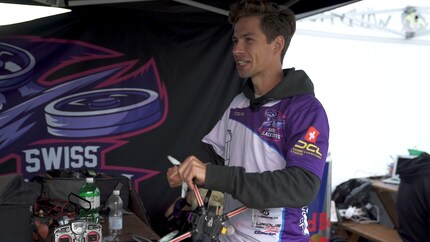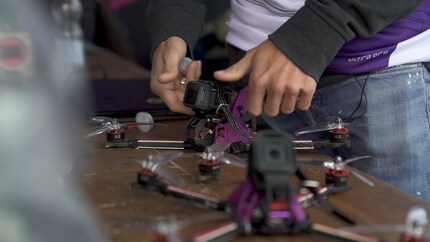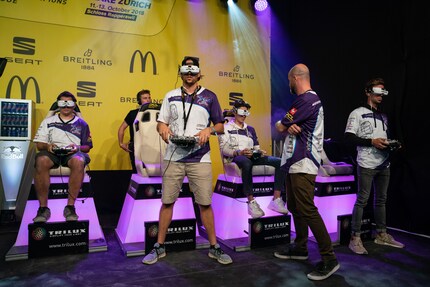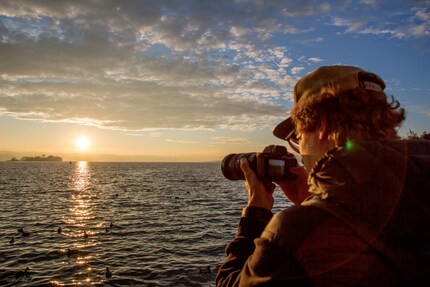Is drone racing even a sport?
Raphael Strähl, drone pilot at the Drone Champions League, gave us a look behind the scenes. In this interview, we find out how he prepares for a competition and how many drones he wrecks each season.
It's Thursday afternoon, mid-October. One of the last summery days of the year. Our local contact in Rapperswil is Raphael Strähl, a drone pilot in the DCL. He flies for the Swiss team Swiss Black Kites and gives us an insight into his world today. I meet Raphael in front of the rider paddock. Here, one pavilion follows the next. A different team has taken up residence in each one. In comparison to a Formula 1 race, you can experience first-hand how the drivers prepare. Only a small barrier prevents spectators from standing in the middle of the team pavilions. Germany, China, USA, Japan, England, Czech Republic and finally Switzerland. Although the teams all have their own names, they all fly under the flag of their respective countries. When we arrive at the Swiss Black Kites - the Swiss team - Manuel and I meet the rest of Raphael's team-mates. Their team consists of four pilots and a coach.

Source: Manuel Wenk
The training flights begin soon, but Raphael still has to prepare his drone beforehand. He attaches the propellers, checks the battery and attaches the GoPro. I ask him whether he needs to make any fine adjustments to his drone before the test flight. "No! We've already been training for this competition for weeks and are working intensively on the respective track. Me and my team recreate the entire race track in advance. Every gate, every flag and every element is set up as precisely as possible. Then we try to fly around the track as quickly as possible with our drones. We make the adjustments to the drones during training. If we only did that now, we wouldn't stand a chance in the competition."

Source: Manuel Wenk
I'm surprised at how seriously the teams are preparing for this competition. I have to admit that I didn't recognise this "sport" as such until today. Of course, not everyone can do it, but the pilots just sit around and twiddle their remote control a bit. How wrong I was. Raphael explains it like this: "It's a sport. First and foremost, it's a competition in which skills compete against skills. We need strong cognitive skills, but physical components also play a role. Anyone who has ever stood on the stage here as a pilot knows what I'm talking about. As a pilot, you're completely in a rush when you're flying, your adrenalin is pumping and your heart starts pumping. It's tiring and exhausting, plus we're outside all day and on our feet for 12 hours."
When you're flying, as a pilot you're completely in a rush, the adrenaline kicks in and your heart starts pumping.
In the background, I can constantly hear the drones of other teams already doing their laps on the track. It's amazing how loud these things are when they're shooting through the air at 140 kilometres an hour. The training flights are completed alternately by one team at a time. Now it's the turn of Raphael and his crew. However, before they can take their place on the stage, their drones still have to be approved by the race organisers. Although the teams are allowed to build their own drones and determine individual components themselves, the DCL has clear regulations on what is and is not permitted. "The drone must weigh at least 780 grams, it may only be operated with 4S batteries, it must be a certain size and have enough LEDs. This is checked before each race and non-compliance is penalised by the race organisers," says Raphael.

Source: Mathias Kniepeiss
Raphael flies cautiously on the first run. In the second run, he then turns up the speed and makes riskier manoeuvres. Unfortunately, this leads to his drone crashing into the branches of a tree and crashing. The drone is still intact. They can take a lot. "I have four drones with me. Two are needed as a minimum, as we always have two runs in a row. I have two more with me as a reserve, as we fly over water here in Rapperswil. If something goes wrong, I have to let the wet drone dry before I can take it back into the air. It can also happen that I fly into a wall and the drone suffers total damage. That's why it's an advantage to have an additional back-up in your luggage." Total loss? That sounds spectacular. :) I follow up and ask Raphael how often this happens? "This season has gone quite well. I haven't destroyed that many drones yet. In Munich and Brussels, however, two copters unfortunately drowned in the water, which ruined all the electronics. I then had to completely rebuild them. Apart from that, I wrecked four arms and two side plates, but the main frame and most of the components are still alive."
I can also fly into a wall and total the drone. That's why it's an advantage to have an additional back-up in your luggage.
In the meantime, the evening has arrived. The sun is slowly setting over Lake Zurich, bathing the entire panorama in a kitschy orange colour. Raphael and his team have said goodbye to us and disappeared with the other pilots for dinner. Manuel and I grab a snack at the refreshment stand and treat ourselves to an after-work beer on the lake shore. It's great to see how well the pilots get on and chat to each other, even though they are competitors on paper. The pilots are one big family who share the same passion and enjoy competing with their drones. Earlier that afternoon, I asked Raphael where he sees drone racing in five years' time: "We are practising this sport at a semi-professional level. Everyone in my team works part-time or, like me, is still studying. Maybe in five years, we'll be able to make a living from it."

You can find our entire drone racing range here.